Charles E W Bean, Diaries, AWM38 3DRL 606/249/1 - 1917 - 1932 - Part 18
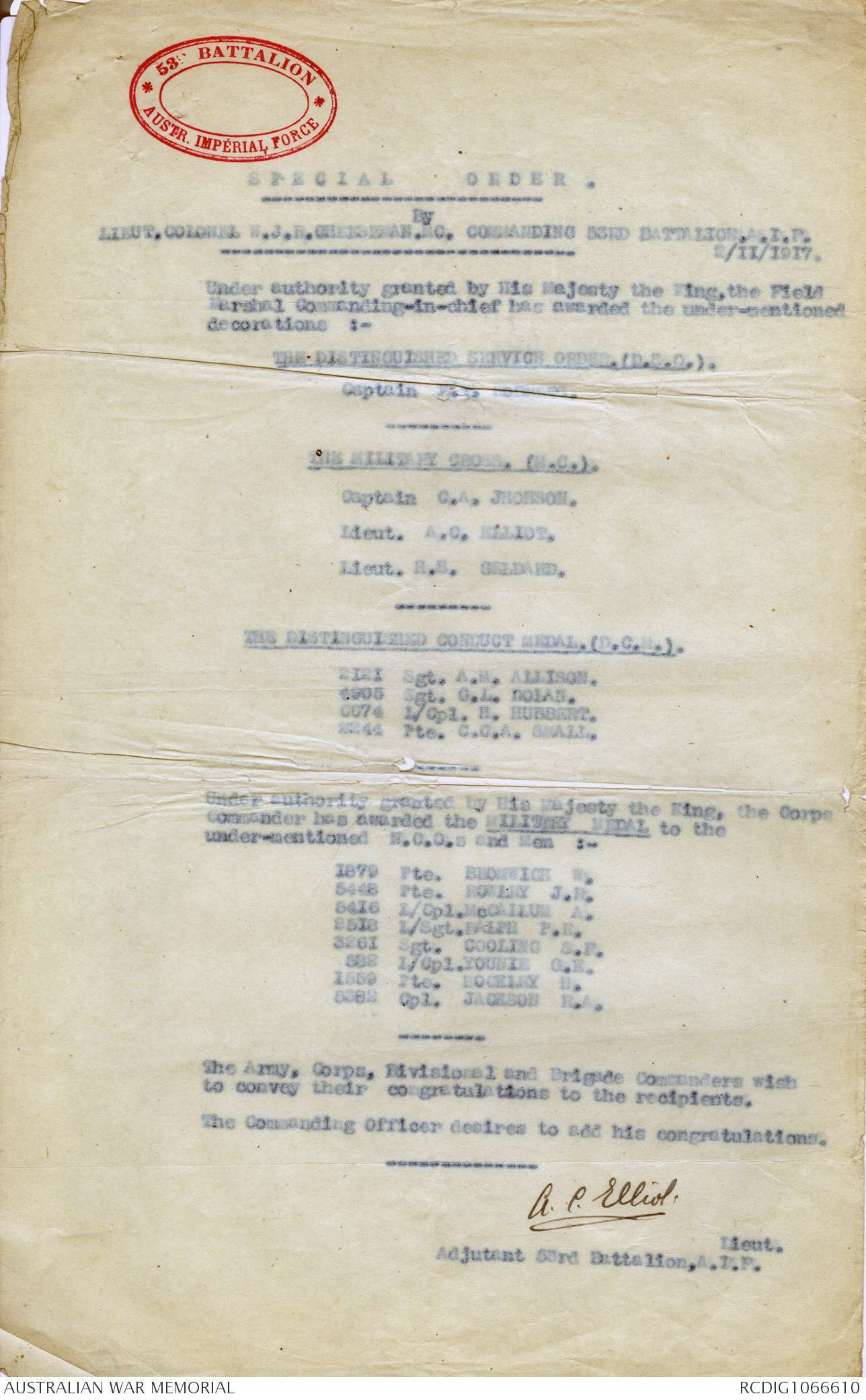
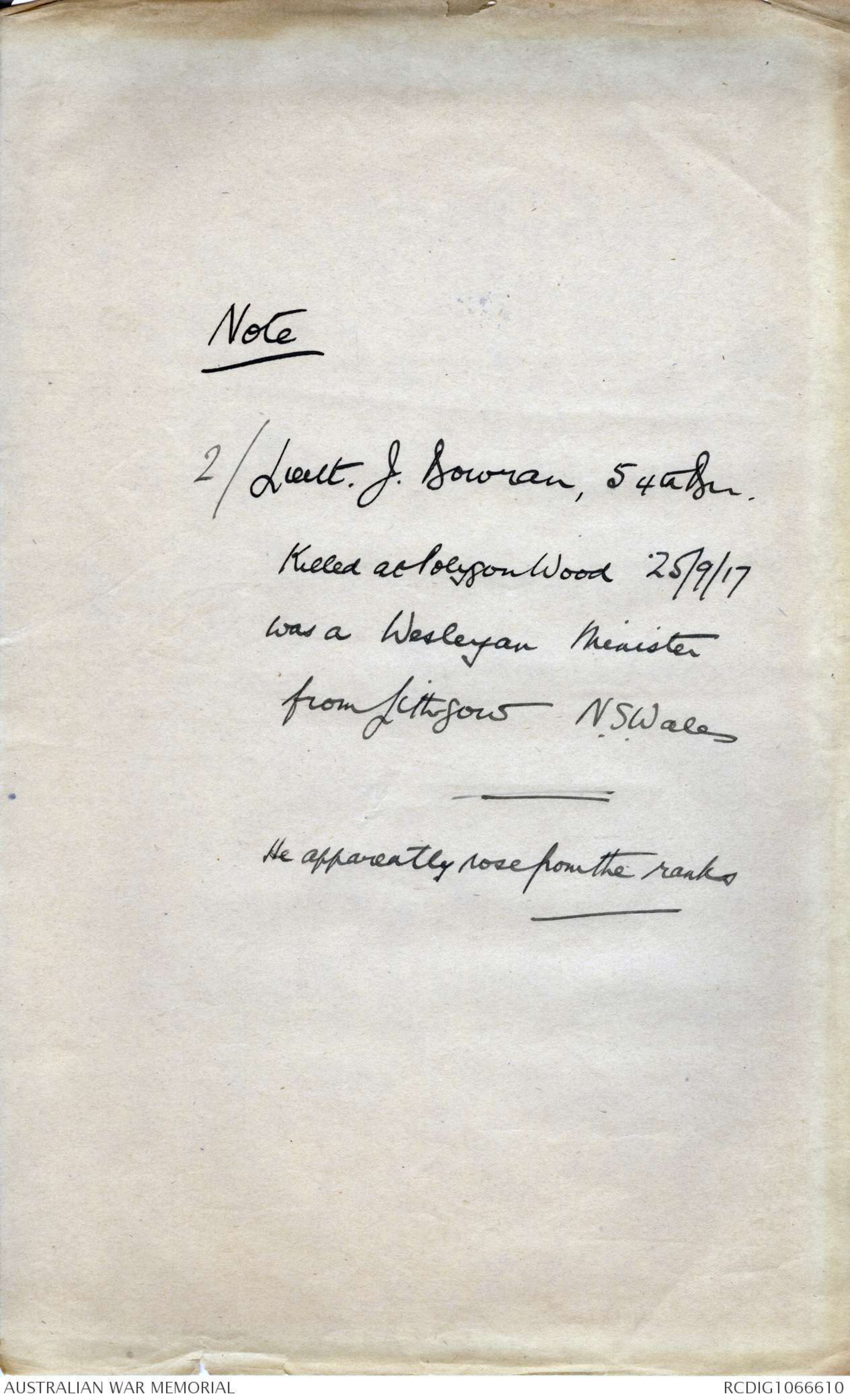
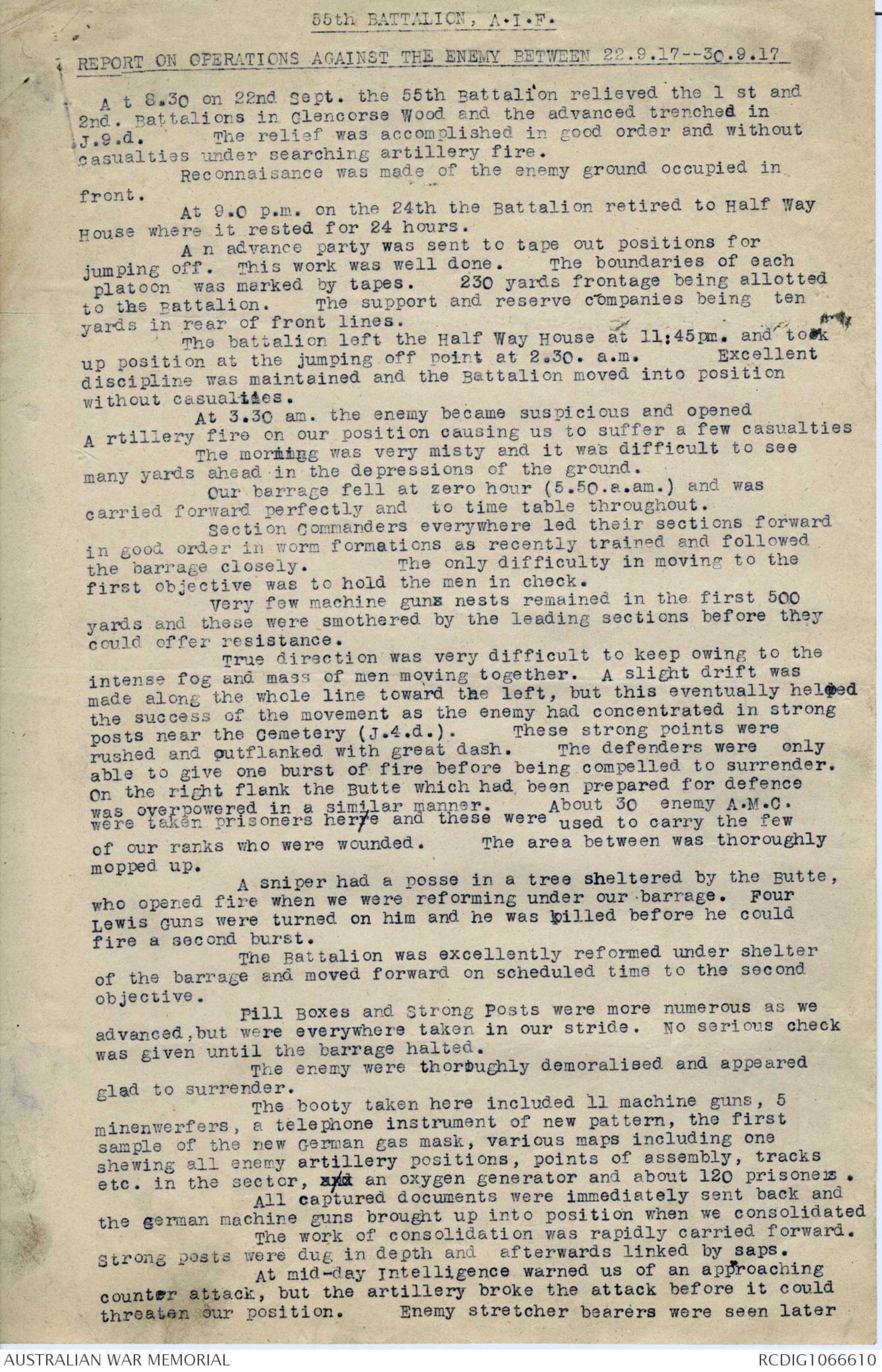
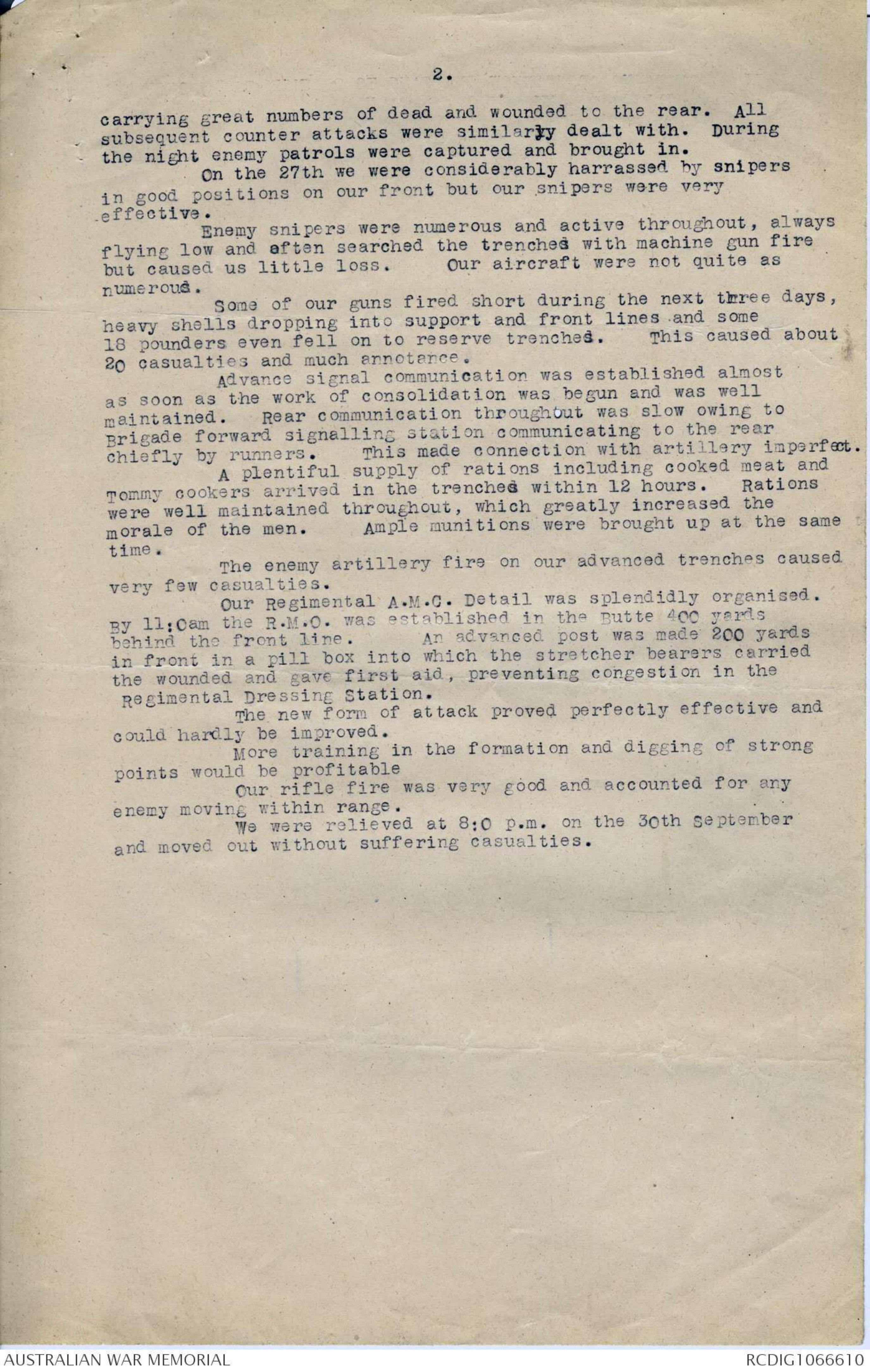
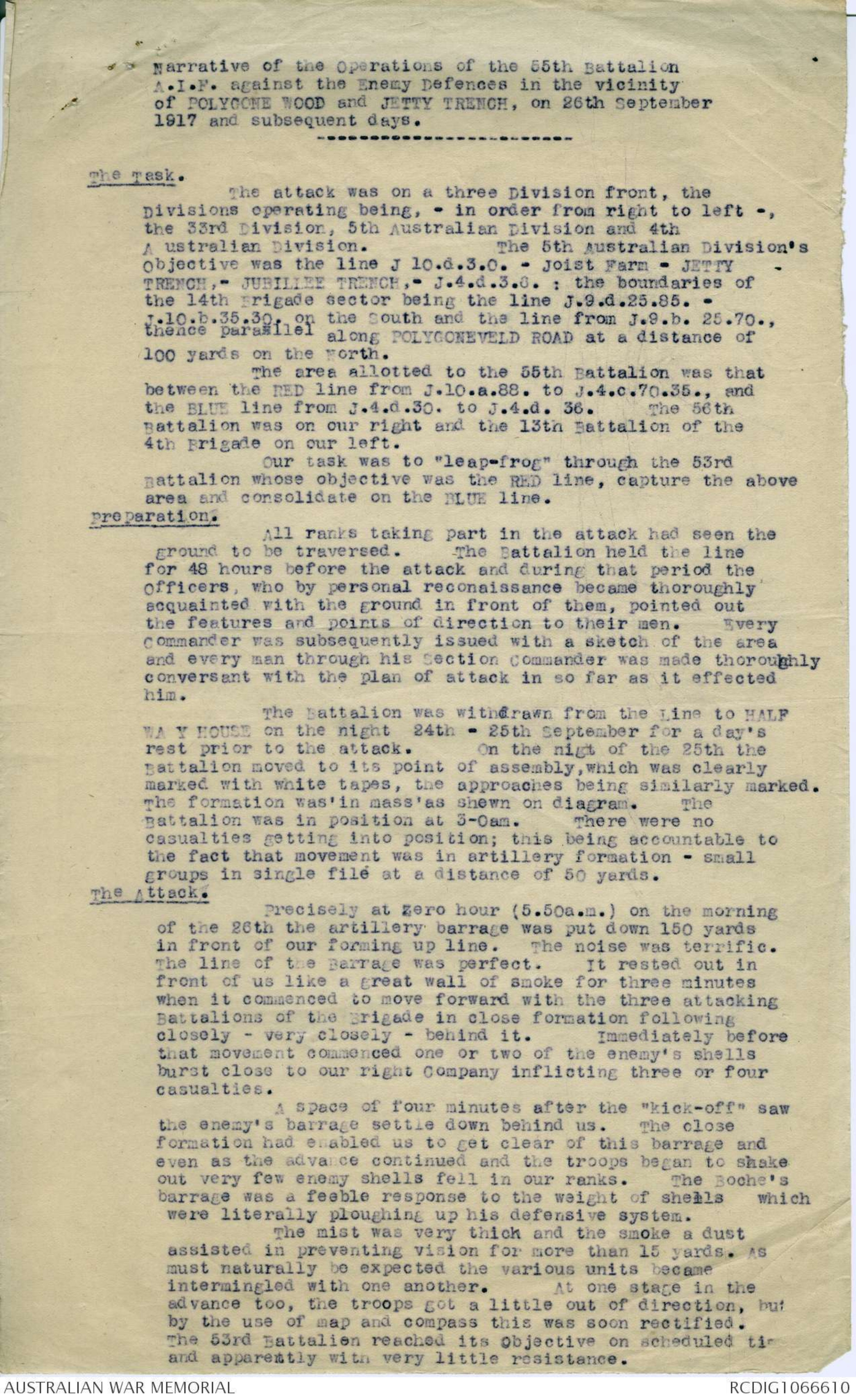

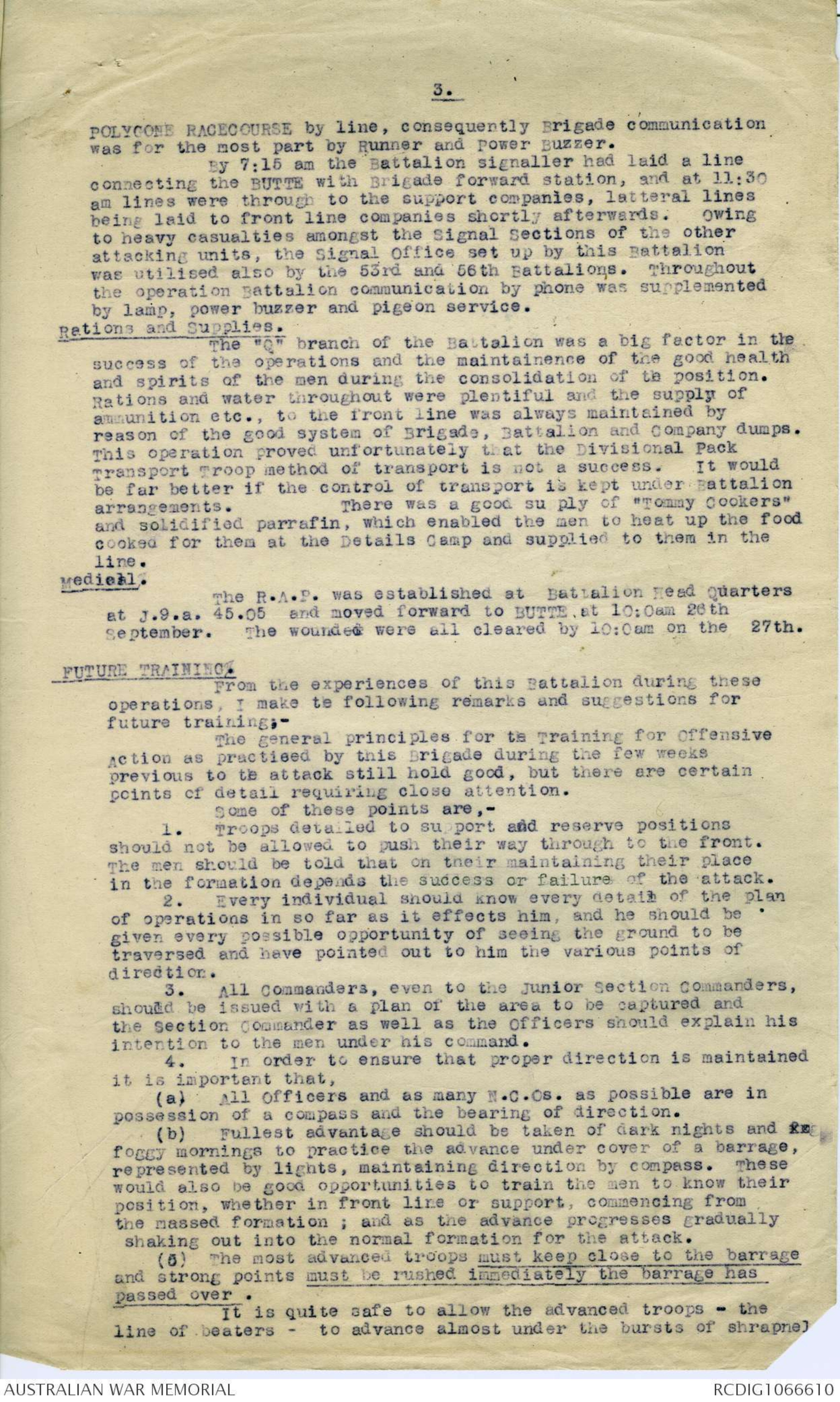
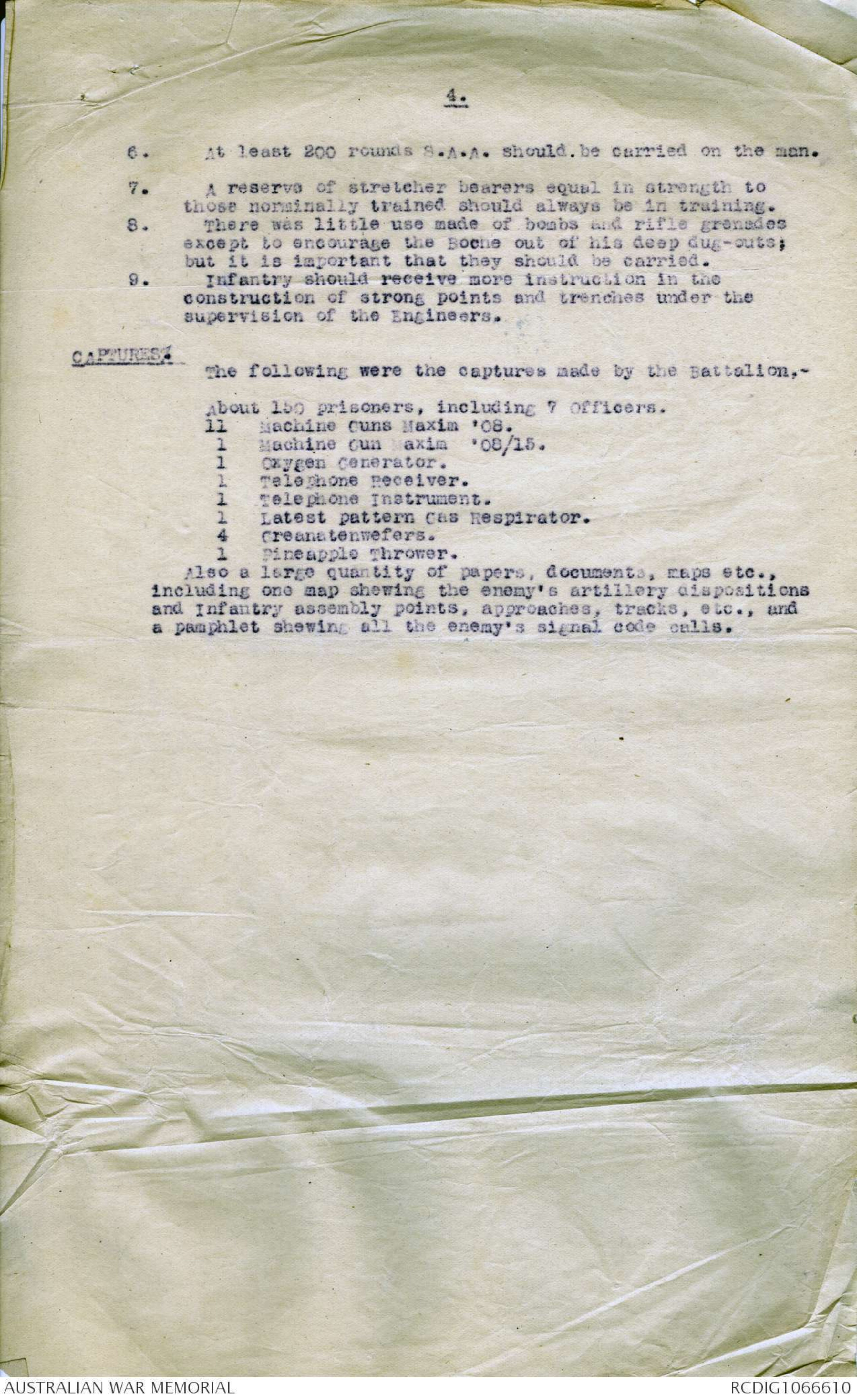
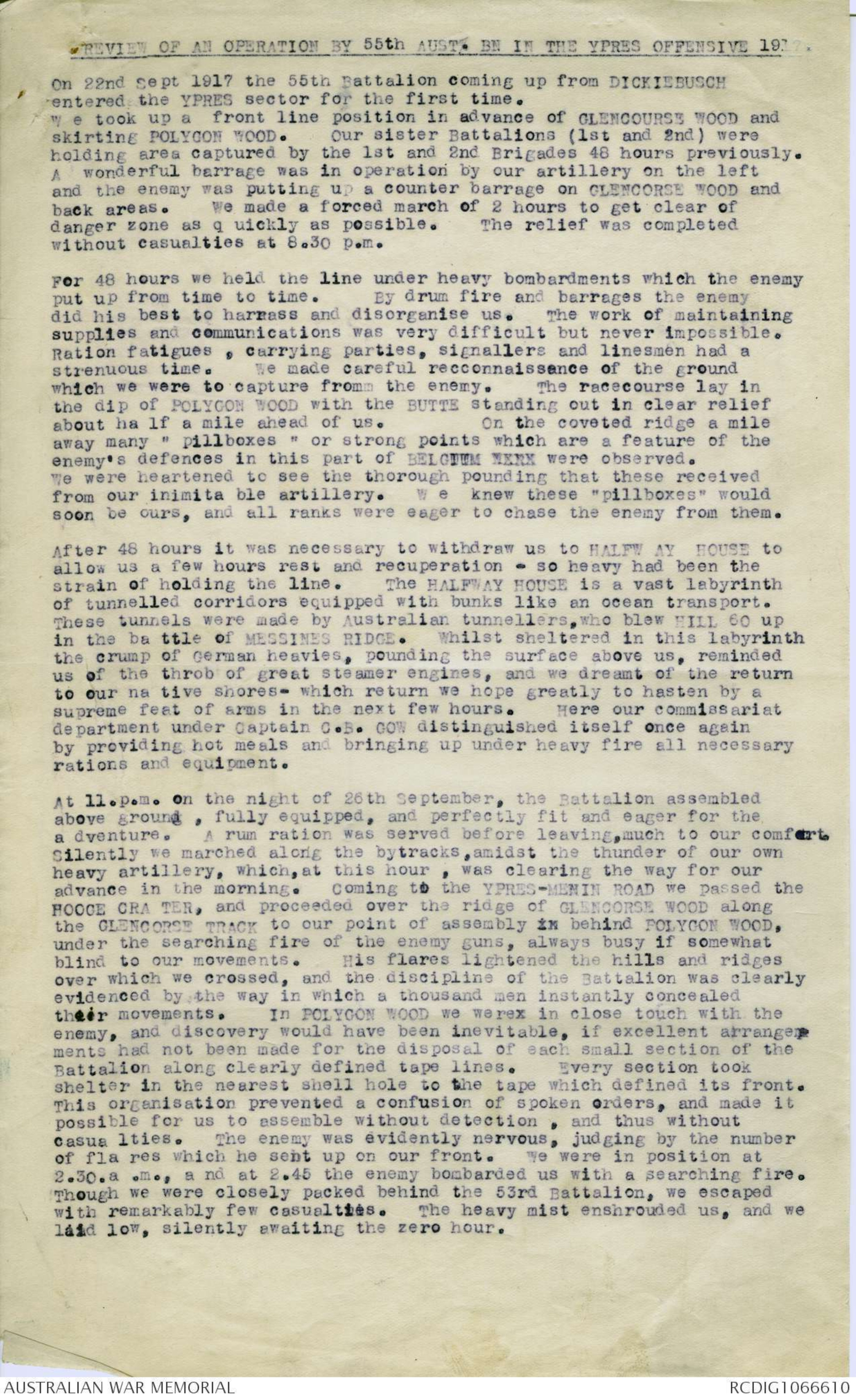
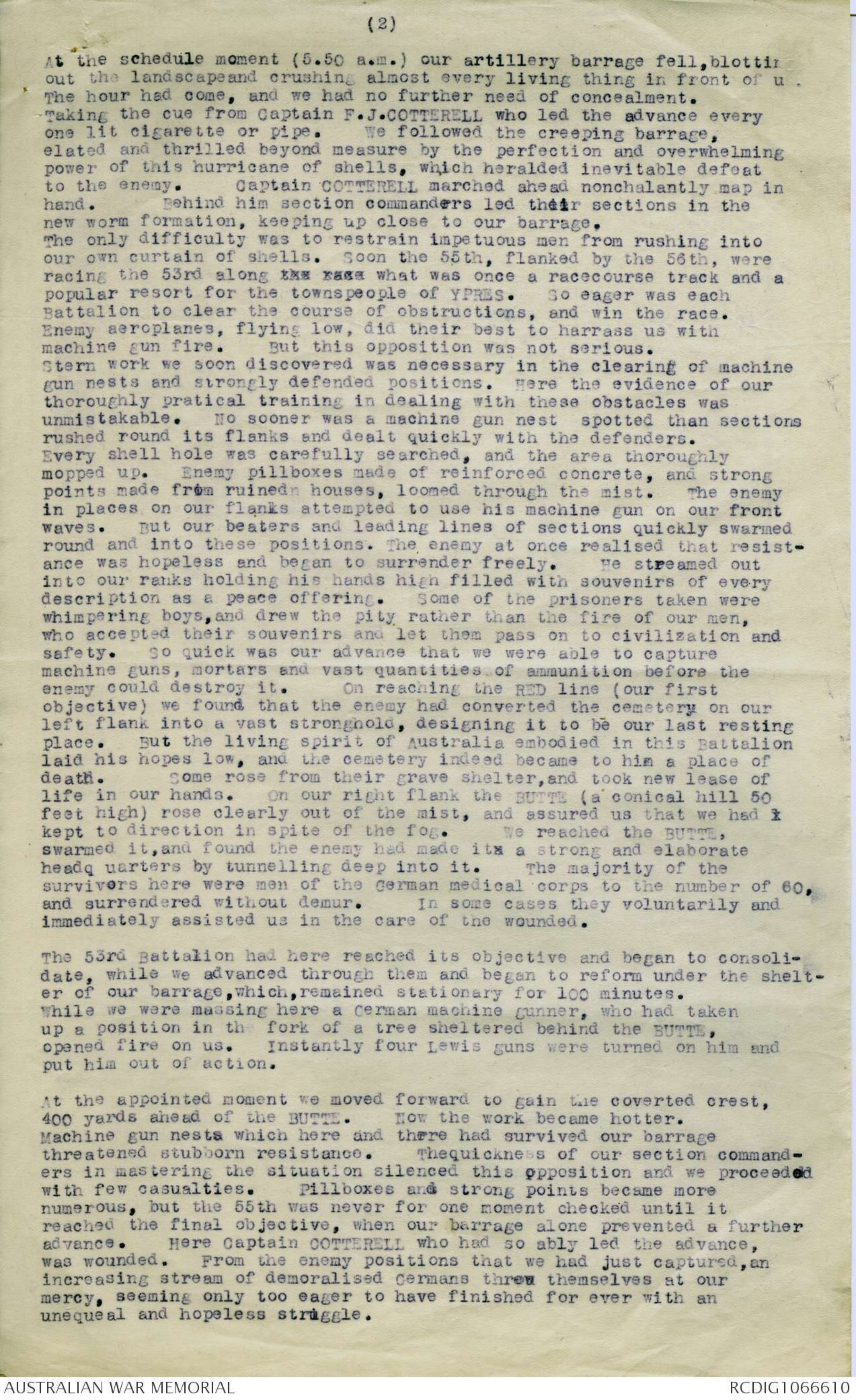
53rd BATTALION
AUSTR. IMPERIAL FORCE
SPECIAL ORDER
-------------------
BY
LIEUT.COLONEL W.J.R. CHEESEMAN.MC. COMMANDING 53RD BATTALION A.I.F.
---------------------------------------------------------------- 2/11/1917.
Under authority granted by His Majesty the KIng,the Field
Marshal Commanding-in-chief has awarded the under-mentioned
decorations :-
THE DISTINGUISHED SERVICE ORDER. (D.S.O.)
Captain P.T. Roberts
-----------------
THE MILITARY CROSS. (M.C.).
Captain C.A. JHONSON
Lieut. A.C. ELLIOT.
Lieut. H.. GELDARD
----------------
THE DISTINGUISHED CONDUCT MEDAL (D.C.M.).
| 2121 | Sgt. | A.M. ALLISON |
| 4905 | Sgt. | G.L. DOLAN |
| 0074 | L/Cpl | R. HUBBERT |
| 2244 | Pte. | C.C.A. SMALL |
----------------
Under authority granted by His Majesty the King, the Corps
Commander has awarded the MILITARY MEDAL to the
under-mentioned N.C.O.s and Men:-
| 1879 | Pte. | BROMWICH W. |
| 5448 | Pte. | ROWLEY J.R. |
| 5416 | L/Cpl. | McCALLUM A. |
| 2518 | L/Sgt. | RAPH P.E. |
| 3261 | Sgt. | COOLING S.F. |
| 528 | L/Cpl. | YOUNIE G.E. |
| 1559 | Pte. | HOCKLEY H. |
| 5382 | Cpl. | JACKSON R.A. |
----------------
The Army, Corps, Divisional and Brigade Commanders wish
to convey their co gratulations to the recipients.
The Commanding Officer desires to add his congratulations.
----------------
A. P. Elliot.
Leiut.
Adjutant 53rd Battalion,A.I.F.
Note
2/Lieut J. Bowman, 54th Bn
Killed at Polygon Wood 25/9/17
was a Wesleyan Minister
from Lithgow N.S.Wales
He apparently rose from the ranks
55th BATTALION, A.I.F.
REPORT ON OFERATIONS AGAINST THE ENENY BETWEEN 22.9.17--30.9.17
At 8.30 on 22nd sept. the 55th Battalion relieved the 1 st and
2nd. Battalions in Glencorse Wood and the advanced trenched in
J.9.d. The relief was accomplished in good order and without
casualties under searching artillery fire
Reconnaissance was made of the enemy ground occupied in
front.
At 9.0 p.m. on the 24th the Battalion retired to Half Way
House where it rested for 24 hours.
A n advance party was sent to tape out positions for
jumping off. This work was well done. The boundaries of each
platoon, was marked by tapes. 230 yards frontage being allotted
to the Battalion. The support and reserve companies being ten
yards in rear of front lines.
The battalion left the Half Way House at 11:45pm. and took
up position at the jumping off point at 2.30. a.m. Excellent
discipline was maintained and the Battalion moved into position
without casualties.
At 3.30 am. the enemy became suspicious and opened
A rtillery fire on our position causing us to suffer a few casualties
The morning was very misty and it was difficult to see
many yards ahead in the depressions of the ground.
Our barrage fell at zero hour (5.50.am.) and was
carried forward perfectly and to time table throughout.
Section Commanders everywhere led their sections forward
in good order in worm formations as recently trained and followed
the barrage closely. The only difficulty in moving to the
first objective was to hold the men in check.
Very few machine guns nests remained in the first 500
yards and these were smothered by the leading sections before they
could offer resistance.
True direction was very difficult to keep owing to the
intense fog and mass of men moving together. A slight drift was
made along the whole line toward the left, but this eventually helped
the success of the movement as the enemy had concentrated in strong
posts near the cemetery (J.4.d.). These strong points were
rushed and outflanked with great dash. The defenders were only
able to give one burst of fire before being compelled to surrender.
On the right flank the Butte which had been prepared for defence
was overpowered in a similar manner. About 30 enemy A.M.C.
were taken prisoners herre and these were used to carry the few
of our ranks who were wounded. The area between was thoroughly
mopped up.
A sniper had a posse in a tree sheltered by the Butte,
who opened fire when we were reforming under our barrage. Four
Lewis guns were turned on him and he was killed before he could
fire a second burst.
The Battalion was excellently reformed under shelter
of the barrage and moved forward on scheduled time to the second
objective.
Pill Boxes and Strong Posts were more numerous as we
advanced, but were everywhere taken in our stride. No serious check
was given until the barrage halted.
The enemy were thoroughly demoralised and appeared
glad to surrender.
The booty taken here included 11 machine guns, 5
minenwerfers, a telephone instrument of new pattern, the first
sample of the new German gas mask, various maps including one
shewing all enemy artillery positions, points of assembly, tracks
etc. in the sector, and an oxygen generator and about 120 prisoner.
All captured documents were immediately sent back and
the german machine guns brought up into position when we consolidated
The work of consolidation was rapidly carried forward.
strong posts were dug in depth and afterwards linked by saps.
At mid-day Intelligence warned us of an approaching
counter attack, but the artillery broke the attack before it could
threaten our position. Enemy stretcher bearers were seen later
2.
carrying great numbers of dead and wounded to the rear. All
subsequent counter attacks were similarly dealt with. During
the night enemy patrols were captured and brought in.
On the 27th we were considerably harrassed by snipers
in good positions on our front but our snipers were very
effective.
Enemy snipers were numerous and active throughout, always
flying low and often searched the trenches with machine gun fire
but caused us little loss. Our aircraft were not quite as
numerous.
Some of our guns fired short during the next three days,
heavy shells dropping into support and front lines and some
18 pounders even fell on to reserve trenches. This caused about
20 casualties and much annotance
Advance signal communication was established almost
as soon as the work of consolidation was begun and was well
maintained. Rear communication throughout was slow owing to
Brigade forward signalling station communicating to the rear
chiefly by runners. This made connection with artillery imperfect
A plentiful supply of rations including cooked meat and
Tommy cookers arrived in the trenches within 12 hours. Rations
were well maintained throughout, which greatly increased the
morale of the men. Ample munitions were brought up at the same
time.
The enemy artillery fire on our advanced trenches caused
very few casualties.
Our Regimental A.M.C. Detail was splendidly organised.
By 11:0am the R.M.O. was established in the Butte 400 yards
behind the front line. An advanced post was made 200 yards
in front in a pill box into which the stretcher bearers carried
the wounded and gave first aid, preventing congestion in the
Regimental Dressing Station.
The new form of attack proved perfectly effective and
could hardly be improved.
More training in the formation and digging of strong
points would be profitable
Our rifle fire was very good and accounted for any
enemy moving within range.
We were relieved at 8:0 p.m. on the 30th september
and moved out without suffering casualties.
Narrative of the operations of the 55th Battalion
A.l.F. against the Enemy Defences in the vicinity
of POLYGCONE WOOD and JETTY TRENCH, on 26 September
1817 and subsequent days.
-----------------------
The Task.
The attack was on a three Division front, the
Divisions operating being, - in order from right to left -
the 33rd Division, 5th Australian Division and 4th
A ustralian Division. The 5th Australian Division's
objective was the line J 10.d.3.0. - Joist Farm - JETTY
TRENCH,- JUBILLEE TRENCH,- J.4.d.3.0.: the boundaries of
the 14th Brigade sector being the line J.9.d.25.85. -
J.10.b.35.30 on the South and the line from J.9.b. 25.70.,
thence parallel along POLYGONEVELD ROAD at a distance of
l00 yards on the North.
The area allotted to the 55th Battalion was that
between the RED line from J.10.a.88. to J.4.c.70.35., and
the BLUE line from J.4.d.30. t0 J.4.d. 36. The 56th
Battalion was on our right and the 13th Battalion of the
4th Brigade on our left.
Our task was to "leap-frog" through the 53d
Battalion whose objective was the RED line, capture the above
area and consolidate on the BLUE line.
Preparation.
All ranks taking part in the attack had seen the
ground to be traversed. The Battalion held the line
for 48 hours before the attack and during that period the
officers, who by personal reconnaissance became thoroughly
acquainted with the ground in front of them, pointed out
the features and points of direction to their men. Every
commander was subsequently issued with a sketch of the area
and every man through his Section commander was made thoroughly
conversant with the plan of attack in so far as it effected
him.
The Battalion was withdrawn from the Line to HALF
WAY HOUSE on the night 24th - 25th September for a day's
rest prior to the attack. On the night of the 25th the
Battalion moved to its point of assembly, which was clearly
marked with white tapes, the approaches being similarly marked.
The formation was'in mass'as shown on diagram. The
Battalion was in position at 3-0am. There were no
casualties getting into position; this being accountable to
the fact that movement was in artillery formation - small
groups in single filé at a distance of 50 yards.
The Attack.
Precisely at zero hour (5.50a.m.) on the morning
of the 26th the artillery barrage was put down 150 yards
in front of our forming up line. The noise was terrific.
The line of the Barrage was perfect. It rested out in
front of us like a great wall of smoke for three minutes
when it commenced to move forward with the three attacking
Battalions of the Brigade in close formation following
closely - very closely - behind it. Immediately before
that movement commenced one or two of the enemy's shells
burst close to our right Company inflicting three or four
casualties.
A space of four minutes after the "kick-off" saw
the enemy's barrage settle down behind us. The close
formation had enabled us to get clear of this barrage and
even as the advance continued and the troops began to shake
out very few enemy shells fell in our ranks. The Boche's
barrage was a feeble response to the weight of shells which
were literally ploughing up his defensive system.
The mist was very thick and the smoke a dust
assisted in preventing vision for more than 15 yards. As
must naturally be expected the various units became
intermingled with one another. At one stage in the
advance too, the troops got a little out of direction, hut
by the use of map and compass this was soon rectified.
The 53rd Battalion reached its objective on scheduled time
and apparently with very little resistance.
2.
The stay of the barrage for a space in advance of
the RED line enabled the Officers to re-organise the
Battalion for the second advance. Every man knew his place
and very soon each man was in it. At Zero (plus 100
minutes) the barrage increased in intensity and then
commenced its forward movement, this time at the slow rate
of 100 yards in eight minutes.
The 55th Battalion then moved forward simultaneously
with the 56th Battalion on the Right. For but a short
space of time beaters and worm- section formations held
together, but soon the area was covered with little parties
of eight and nine men deployed each looking for its shellhole
full or pill box full of Boche and they found them too;
but the cringing, comarading Hun was not willing to fight,
everywhere surrendering rapidly. Indeed he did not get
much opportunity to show resistance because our men pounced
on him immediately the barrage had passed over him.
Detachments were left behind to clear each pill-box and the
parties of 30 and 40 from these strongholds in the vicinity
of J.4.d.05.20. and 20.10. were quickly escorted to the rear.
The BLUE Line was reached at 8:30am, 18 pounders
smoke shells making the location certain for anyone in doubt.
The troops began to dig in immediately and steps were taken
to establish connection with the flanking units. This was
hampered by machine gun fire from enemy strong holds in the
xxxxxxxxxxxxxxxxxxxxxxxxxxxxxxxxxxxxxxxxxxxxxxin advance of
each flank. These were dealt with by fighting patrols.
When attacked the one on the left, at about J.4.d.30.45
surrendered immediately and we captured here 2 machine guns
and over 20 prisoners. A party of one Officer, one
Sergeant and two others attacked the stronghold on the right,
at about J. 10.b.5.8., which resisted more than ang other pa
point. With the aid of bombs the crew of the machine gun
was put out of action and over 30 prisoners taken as well as
the machine gun. Touch was gained with both flanks at
8:50am. At the time the Objective was reached the
Battalion had only suffered about 7% casualties and the
majority of wounds were slight. There were only three or
four casualties from our own barrage.
Under the protection of our barrage the work of
consolidation was continued and when the barrage died down
at 11:17 am we had established a fairly formidable system
of trenches which when eventually deepened and connected
became the defence system shown on the attached sketch.
We were well prepared therefore for the attempted counter
attacks which followed.
At about 4:0pm the enemy was observed massing,
moving from pillbox to pillbox, but the attack was never
developed.. At about 7:0pm however hundreds of the
enemy were seen coming across the sky-line un small groups
and concentrating at several points. At 7:15pm the enemy
came out in attack formations - advancing in three waves -
but at the desired moment our barrage came down on the
advancing enemy, and those who were not cut up by our
artillery were mowed down by Lewis gun and rifle fire
The Boche did not reach our lines at any point. There were
no further attempts made. If it was his intention to
counter attack at dawn on the 27th his attempt was frustrated
by our barrage which went down at 5:0am.
The Battalion continued to hold the line until the
night of the 30th September / 1st October when we were
relieved by the 20th Manchesters.
The total casualties numbered, Officers -
wounded 7, shell shock 1 ; Other Ranks, Killed 40, wounded
137.
Communication.
Conmunication, in so far as the Battalion system
of communication is concerned, was good. unfortunately, the
cable head was destroyed by shell fire, with the result that
the Brigade could not connect with their forward station on
3.
POLYGONE RACECOURSE by line, consequently Brigade communication
was for the most part by Runner and Power Buzzer.
By 7:15 am the Battalion signaller had laid a line
connecting the BUTTE with Brigade forward station, and at 11:30
am lines were through to the support companies, latteral lines
being laid to front line companies shortly afterwards. Owing
to heavy casualties amongst the Signal Sections of the other
attacking units, the Signal Office set up by this Battalion
was utilised also by the 53rd and 56th Battalions. Throughout
the operation Battalion communication by phone was supplemented
by lamp, power buzzer and pigeon service.
Rations and Supplies.
The "Q" branch of the Battalion was a big factor in the
success of the operations and the maintainence of the good health
and spirits of the men during the consolidation of th position.
Rations and water throughout were plentiful and the supply of
ammunition etc., to the front line was always maintained by
reason of the good system of Brigade, Battalion and Company dumps.
This operation proved unfortunately that the Divisional Pack
Transport Troop method of transport is not a success. It would
be far better if the control of transport is kept under Battalion
arrangements. There was a good supply of "Tommy Cookers"
and solidified parrafin, which enabled the men to heat up the food
cooked for them at the Details Camp and supplied to them in the
line.
Medical.
The R.A.P. was established at Battalion Head Quarters
at J.9.a. 45.05 and moved forward to BUTTE, at 10:Oam 26th
September. The wounded were all cleared by 10:Oam on the 27th.
FUTURE TRAINING.
From the experiences of this Battalion during these
operations, I make te following remarks and suggestions for
future training:-
The general principles for ta Training for Offensive
Action as practiced by this Brigade during the few weeks
previous to te attack still hold good, but there are certain
points of detail requiring close attention.
Some of these points are,-
1. Troops detailed to support and reserve positions
should not be allowed to push their way through to the front.
The men should be told that on their maintaining their place
in the formation depends the sudcess or failure of the attack.
2. Every individual should know every detain of the plan
of operations in so far as it effects him, and he should be
given every possible opportunity of seeing the ground to be
traversed and have pointed out to him the various points of
direction.
3. All Commanders, even to the Junior Section Commanders,
should be issued with a plan of the area to be captured and
the Section Commander as well as the Officers should explain his
intention to the men under his command.
4. In order to ensure that proper direction is maintained
it is important that,
(a) All Officers and as many N.C.Os. as possible are in
possession of a compass and the bearing of direction.
(b) Fullest advantage should be taken of dark nights and xx
foggy mornings to practice the advance under cover of a barrage,
represented by lights, maintaining direction by compass. These
would also be good opportunities to train the men to know their
position, whether in front line or support, commencing from
the massed formation ; and as the advance progresses gradually
shaking out into the normal formation for the attack.
(5) The most advanced troops must keep close to the barrage
and strong points must be rushed immediately the barrage has
passed over.
It is quite safe to allow the advanced troops - the
line of beaters - to advance almost under the bursts of shrapnel
4.
6. At least 200 rounds S.A.A. should.be carried on the man.
7. A reserve of stretcher bearers equal in strength to
those norminally trained should always be in training.
8. There was little use made of bombs and rifle grenades
except to encourage the Boche out of his deep dug-outs;
but it is important that they should be carried.
9. Infantry should receive more instruction in the
construction of strong points and trenches under the
supervision of the Engineers.
CAPTURES.
The following were the captures made by the Battalion,
About 150 prisoners, including 7 officers.
11 machine guns Maxim 'O8.
1 Machine gun Maxim 'O8/15.
1 Oxygen Generator.
1 Telephone Receiver.
1 Telephone Instrument.
1 Latest pattern gas Respirator.
4 Greanatenwefers.
1 Pineapple Thrower.
Also a large quantity of papers, documents, maps etc.,
including one map showing the enemy's artillery dispositions
and Infantry assembly points, approaches, tracks, etc., and
a pamphlet showing all the enemy's signal code calls.
REVIEW OF AN OPFERATION BY 55th AUST. BN IN THE YPRES OFFENSIVE 1917.
On 22nd sept 1917 the 55th Battalion coming up from DICKIEBUSCH
entered the YPRES sector for the first time.
We took up a front line position in advance of GLENCOURSE WOOD and
skirting POLYCOH WOOD. Our sister Battalions (1st and 2nd) were
holding area captured by the 1st and 2nd Brigades 48 hours previously.
A wonderful barrage was in operation by our artillery on the left
and the enemy was putting up a counter barrage on GLENCORSE WOOD and
back areas. We made a forced march of 2 hours to get clear of
danger zone as q uickly as possible. The relief was completed
without casualties at 8.30 p.m.
For 48 hours we held the line under heavy bombardments which the enemy
put up from time to time. By drum fire and barrages the enemy
did his best to harress and disorganise us. The work of maintaining
supplies and communications was very difficult but never impossible.
Ration fatigues, carrying parties, signallers and linesmen had a
strenuous time. We made careful reconnaissance of the ground
which we were to capture from the enemy. The racecourse lay in
the dip of POLYFON WOOD with the BUTTE standing out in clear reliefI
about ha If a mile ahead of us. On the coveted ridge a mile
away many " pillboxes " or strong points which are a feature of the
enemy's defences in this part of BELGIUM XXXX were observed.
We were heartened to see the thorough pounding that these received
from our inimita ble artillery. We knew these " pillboxes " would
soon be ours, and all ranks were eager to chase the enemy from them.
After 48 hours it was necessary to withdraw us to HAIFW AY HOUSE to
allow us a few hours rest and recuperation - so heavy had been the
strain of holding the line. The HALFWAY HOUSE is a vast labyrinth
of tunnelled corridors equipped with bunks like an ocean transport.
These tunnels were made by Australian tunnellers, who blew HILL 60 up
in the ba ttle of MESSINES RIDCE. Whilst sheltered in this labyrinth
the crump of German heavies, pounding the surface above us, reminded
us of the throb of great steamer engines, and we dreamt of the return
to our na tive shores- which return we hope greatly to hasten by a
supreme feat of arms in the next few hours. Here our commissariat
department under Captain C.B. GOW distinguished itself once again
by providing hot meals and bringing up under heavy fire all necessary
rations and equipment.
At 11.p.m. on the night of 26th September, the Battalion assembled
above ground, fully equipped, and perfectly fit and eager for the
a dventure. A rum ration was served before leaving,much to our comfort,
Silently we marched along the bytracks,amidst the thunder of our own
heavy artillery, which, at this hour, was clearing the way for our
advance in the morning. Coming to the YPRES-MENIN ROAD we passed the
HOOGE CRA TER, and proceeded over the ridge of GLENCORSE WOOD along
the GLENCOREF TRACK to our point of assembly in behind POLYGON WOOD,
under the searching fire of the enemy guns, always busy if somewhat
blind to our movements. His flares lightened the hills and ridges
over which we crossed, and the discipline of the Battalion was clearly
evidenced by the way in which a thousand men instantly concealed
their movements. In POLYGON WOOD we werex in close touch with the
enemy, and discovery would have been inevitable, if excellent arrangements
had not been made for the disposal of each small section of the
Battalion along clearly defined tape lines. Every section took
shelter in the nearest shell hole to the tape which defined its front.
This organisation prevented a confusion of spoken orders, and made it
possible for us to assemble without detection , and thus without
casua lties. The enemy was evidently nervous, judging by the number
of fla res which he sent up on our front. We were in position at
2.30.a .m., a nd at 2.45 the enemy bombarded us with a searching fire.
Though we were closely packed behind the 53rd Battalion, we escaped
with remarkably few casualties. The heavy mist enshrouded us, and we
laid low, silently awaiting the zero hour.
(2)
At the schedule moment (5.50 a.m.) our artillery barrage fell ,blotting
out the landscapeand crushing almost every living thing in front of us.
The hour had come, and we had no further need of concealment.
Taking the cue from Captain F.J.COTTERELL who led the advance every
one lit cigarette or pipe. We followed the creeping barrage
elated and thrilled beyond measure by the perfection and overwhelming
power of this hurricane of shells, which heralded inevitable defeat
to the enemy. Captain COTTERELL marched ahead nonchalantly map in
hand. Behind him section commanders led their sections in the
new worm formation, keeping up close to our barrage,
The only difficulty was to restrain impetuous men from rushing into
our own curtain of shells. Soon the 55th, flanked by the 56th, were
racing the 53rd along xxx xxxx what was once a racecourse track and a
popular resort for the townspeople of YPRES. So eager was each
Battalion to clear the course of obstructions, and win the race.
Enemy aeroplanes, flying low, did their best to harrass us with
machine gun fire. But this opposition was not serious.
Stern work we soon discovered was necessary in the clearing of machine
gun nests and strongly defended positions. Here the evidence of our
thoroughly pratical training in dealing with these obstacles was
unmistakable. No sooner was a machine gun nest spotted than sections
rushed round its flanks and dealt quickly with the defenders.
Every shell hole was carefully searched, and the area thoroughly
mopped up. Enemy pillboxes made of reinforced concrete, and strong
points made from ruinedn houses, loomed through the mist. The enemy
in places on our flanks attempted to use his machine gun on our front
waves. But our beaters and leading lines of sections quickly swarmed
round and into these positions. The enemy at once realised that resistance
was hopeless and began to surrender freely. He streamed out
into our ranks holding his hands high filled with souvenirs of every
description as a peace offering. Some of the prisoners taken were
whimpering boys,and drew the pity rather than the fire of our men,
who accepted their souvenirs and let them pass on to civilization and
safety. So quick was our advance that we were able to capture
machine guns, mortars and vast quantities of ammunition before the
enemy could destroy it. On reaching the RED line (our first
objective) we found that the enemy had converted the cemetery on our
left flank into a vast stronghold, designing it to be our last resting
place. But the living spirit of Australia embodied in this Battalion
laid his hopes low, and the cemetery indeed became to him a place of
death. Some rose from their grave shelter,and took new lease of
life in our hands. On our right flank the BUTTE (a conical hill 50
feet high) rose clearly out of the mist, and assured us that we had x
kept to direction in spite of the fog. We reached the BUTTE,
swarmed it,and found the enemy had made its a strong and elaborate
headq uarters by tunnelling deep into it. The majority of the
survivors here were men of the German medical corps to the number of 60,
and surrendered without demur. In some cases they voluntarily and
immediately assisted us in the care of the wounded.
The 53rd Battalion had here reached its objective and began to consolidate,
while we advanced through them and began to reform under the shelter
of our barrage,which,remained stationary for 100 minutes.
While we were massing here a German machine gunner, who had taken
up a position in the fork of a tree sheltered behind the BUTTE,
opened fire on us. Instantly four Lewis guns were turned on him and
put him out of action.
At the appointed moment we moved forward to gain the coverted crest,
400 yards ahead of the BUTTE. Now the work became hotter.
Machine gun nests which here and there had survived our barrage
threatened stubborn resistance. Thequickness of our section commanders
in mastering the situation silenced this opposition and we proceeded
with few casualties. Pillboxes and strong points became more
numerous, but the 55th was never for one moment checked until it
reached the final objective, when our barrage alone prevented a further
advance. Here Captain COTTERELL who had so ably led the advance,
was wounded. From the enemy positions that we had just captured, an
increasing stream of demoralised Germans threw themselves at our
mercy, seeming only too eager to have finished for ever with an
unequeal and hopeless struggle.
 Sam scott
Sam scottThis transcription item is now locked to you for editing. To release the lock either Save your changes or Cancel.
This lock will be automatically released after 60 minutes of inactivity.